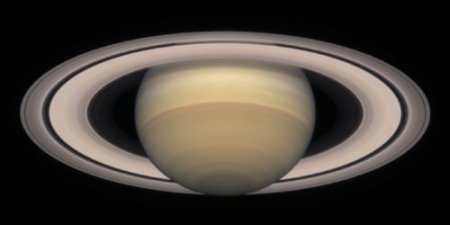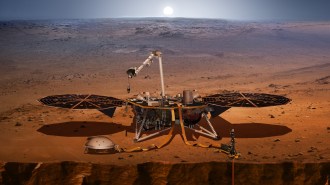Slowdown on Saturn? Windy doings on the ringed planet
The winds in Saturn’s upper atmosphere are some of the swiftest in the solar system, but recent findings suggest there’s been a dramatic slowdown. Observations with the Hubble Space Telescope indicate that the band of wind circling Saturn’s equator is now traveling 270 meters per second, a 40 percent drop from the supersonic speed it had just 22 years ago.

If confirmed, the data offer the first evidence “that wind speeds in the atmospheres of the giant planets can suffer strong changes,” says Agustín Snchez-Lavega of the Universidad del Pais Vasco in Bilbao, Spain. He and his colleagues describe their findings in the June 5 Nature.
|
EYE ON SATURN. Hubble Space Telescope image of the ringed planet, taken in November 2000.
|
The researchers cite several explanations for a possible slowdown. Because Saturn, like Earth, is tilted on its axis, different parts of the ringed planet receive different amounts of sunlight during its 29-year orbit around the sun. If this variation accounts for changes in equatorial wind speed, that speed should change noticeably in about 7 years, the next time Saturn’s equator is tipped toward the sun, comments John T. Clarke of Boston University.
The shadow cast by the planet’s giant ice rings also might affect wind speed by blocking varying amounts of sunlight at the equator. Another possibility, notes Snchez-Lavega, is that a huge equatorial storm system, dubbed the Great White Spot (SN: 11/24/90, p. 325), has disturbed the band of wind.
However, Snchez-Lavega’s team acknowledges that what appears to be a slowdown in wind speed might simply be an artifact of the data. Hubble examined Saturn from 1996 to 2002, and the Voyager spacecraft did so in 1980 and 1981. A comparison of the measurements might be misleading if Hubble measured winds at a higher altitude than those examined by Voyager. Higher-altitude winds on Saturn move more slowly.
Given the “sheer magnitude of the change” in speed, the results are intriguing but demand some skepticism, says Adam P. Showman of the University of Arizona in Tucson. Winds on all planets are directly or indirectly powered by the absorption of sunlight and its radiation into space at infrared wavelengths, Showman notes. He asserts that there isn’t enough solar energy reaching Saturn to slow its equatorial winds at any significant depth below the cloud tops.
On the other hand, if the slowdown is confined to the uppermost altitudes, says Showman, there should be an obvious difference in temperature between the center of the equatorial band and its upper and lower edges.
The atmospheric model that Showman’s criticism relies on isn’t valid in Saturn’s equatorial region, counters Snchez-Lavega. Moreover, no one knows whether major temperature differences exist because measurements weren’t made there during the years Hubble examined the region, he says.
With the Cassini spacecraft scheduled to begin orbiting Saturn in July 2004, “the analysis is quite timely,” notes Reta F. Beebe of New Mexico State University in Las Cruces. Cassini will give researchers “the capability of observing Saturn’s clouds . . . with the best camera and infrared spectrographs we have ever taken to the outer planets,” she says.
****************
If you have a comment on this article that you would like considered for publication in Science News, send it to editors@sciencenews.org. Please include your name and location.







